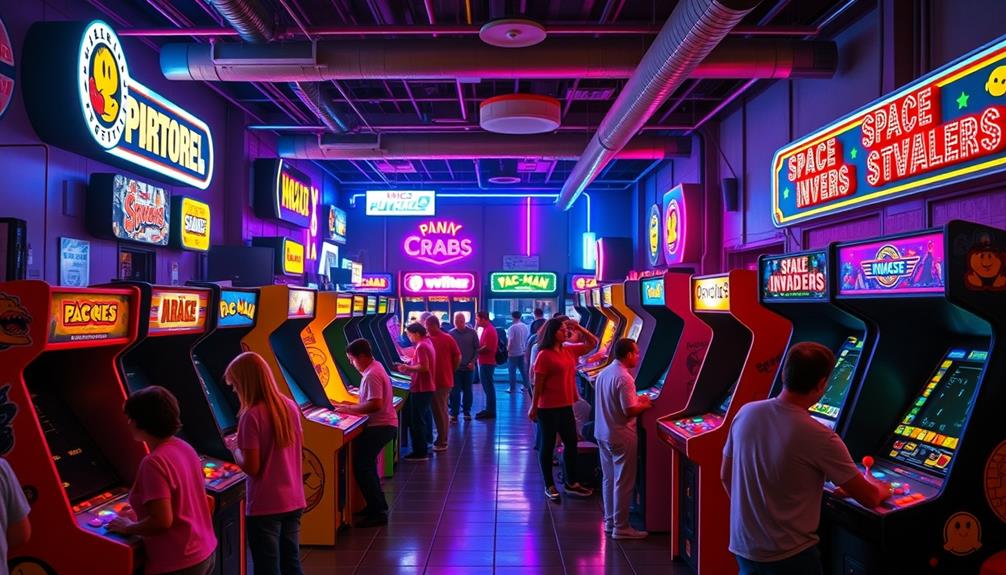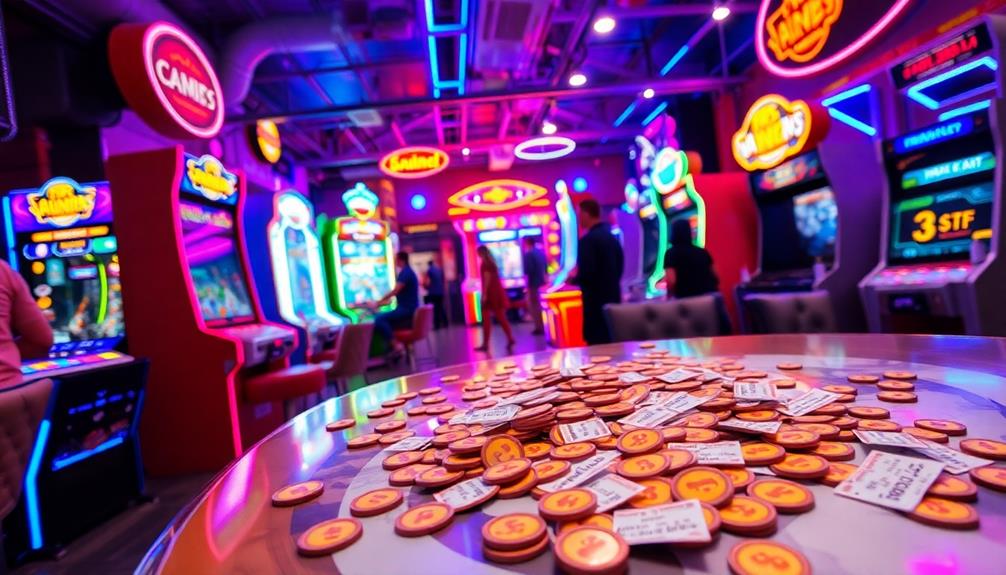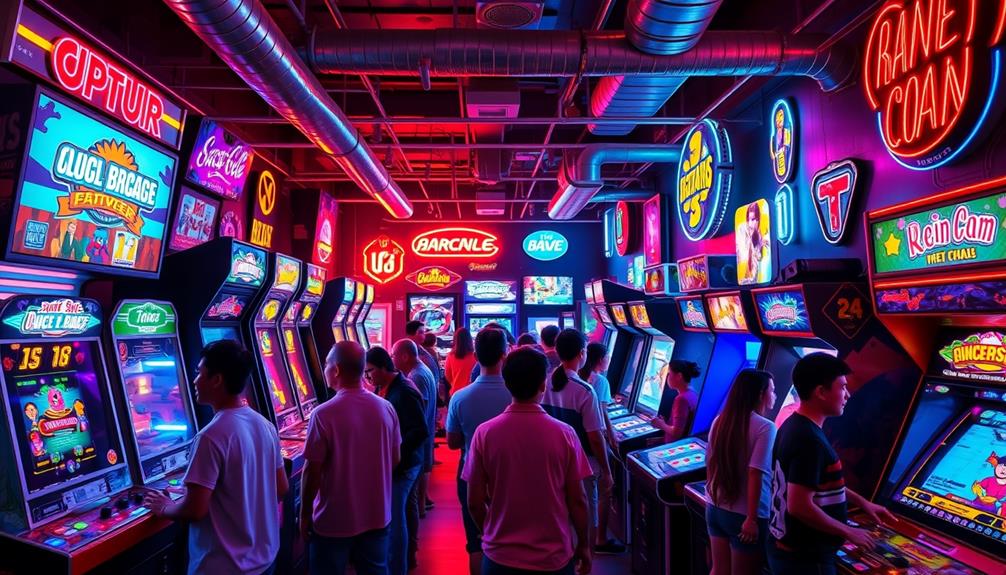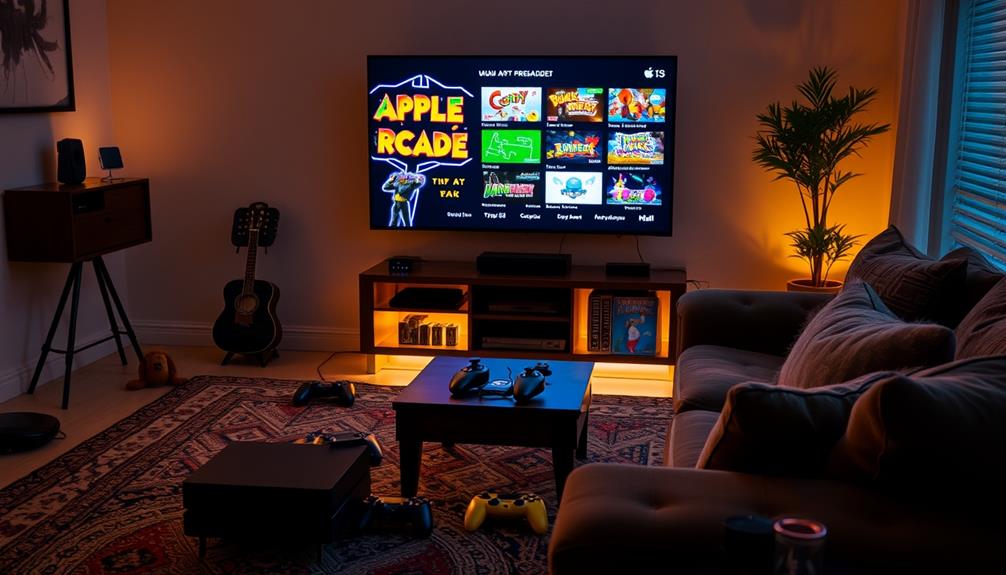In the 1980s, arcade games saw a surge in popularity, with Pac-Man, Space Invaders, and Donkey Kong leading the way. Pac-Man became an iconic figure in popular culture, while Space Invaders helped shape the shooter genre. Arcades were bustling with players striving for high scores in games like Ms. Pac-Man and Galaga. Titles like Robotron: 2084 and Joust introduced new dual joystick controls, revolutionizing gameplay. This era turned gaming into a social activity that captivated millions. If you’re interested in how these games influenced modern gaming, you may be surprised by what you learn next.
Key Takeaways
- *Pac-Man* (1980) became a cultural phenomenon, selling over 400,000 cabinets and generating significant arcade revenue.
- *Space Invaders* (1978) pioneered the shooter genre, grossing $2 billion by 1982 and influencing future games.
- *Donkey Kong* (1981) introduced Mario, shaping the platform genre and becoming a classic arcade title.
- *Ms. Pac-Man* (1982) offered new mazes and smarter enemies, selling 115,000 units and lauded as one of the best sequels.
- *Robotron: 2084* (1982) showcased dual joystick mechanics, revolutionizing fast-paced shooters and cooperative multiplayer experiences.
Overview of 80s Arcade Games
The 1980s kicked off a gaming revolution that transformed arcade culture into a mainstream phenomenon. During this golden age, arcade games surged in popularity, with titles like *Pac-Man* and *Space Invaders* leading the charge. By 1981, *Pac-Man* grossed over $1 billion, while *Space Invaders* earned $2 billion by 1982. These classics captured the hearts of gamers and set the stage for what would become a booming industry.
The vibrant atmosphere of arcades often featured upbeat music, reminiscent of the themes found in a radiant song like *Blue Skies and Lemonade*, enhancing the overall gaming experience.
The arcade scene peaked with around 10,000 arcades operating and generating $8 billion in revenue from coin-operated games by 1982. Among the standout titles, *Ms. Pac-Man* became a best-seller, with 115,000 units sold, earning its place as one of the best sequels in gaming history.
Innovative games like *Robotron: 2084* and *Joust* introduced dual joystick controls and unique mechanics that redefined gameplay.
You can't forget about *Donkey Kong*, which introduced Mario, or *Galaga*, known for its space battles. These classic arcade games not only entertained millions but also laid the foundation for future gaming genres.
The 80s truly reshaped how we view and experience games today.
Iconic Titles and Their Impact

Arcade gaming in the 80s was defined by iconic titles that not only entertained but also reshaped the industry. *Pac-Man* became a cultural phenomenon, enchanting players with its maze-chasing gameplay and vibrant characters. Selling over 400,000 cabinets and grossing more than $1 billion by 1981, it set a benchmark for future arcade games.
Similarly, *Ms. Pac-Man* introduced new mazes and enemy behaviors, selling 115,000 units and earning praise as one of the best sequels. *Donkey Kong* introduced Mario and influenced the platform genre, while *Space Invaders* pioneered the shooter genre, grossing $2 billion by 1982. Finally, *Galaga* captivated you with unique enemy patterns and space battles.
Here's a summary of these iconic titles:
| Game Title | Release Year | Impact |
|---|---|---|
| Pac-Man | 1980 | Cultural phenomenon; over $1 billion |
| Ms. Pac-Man | 1982 | Best arcade sequel; 115,000 units sold |
| Donkey Kong | 1981 | Introduced Mario; influenced platforming |
| Space Invaders | 1978 | Pioneered shooter genre; $2 billion gross |
| Galaga | 1981 | Beloved classic; engaging gameplay |
These games not only defined the arcade landscape but also left a lasting legacy in video games.
Gameplay Innovations of the Era

In the 80s, arcade games transformed with innovative gameplay mechanics that changed how you played.
The evolution of games like *Pac-Man* and *Robotron 2084* reflected advancements in technology, much like the changes seen in pinball machine design that introduced flippers and electronic scoring.
You experienced the thrill of maze chase dynamics in *Pac-Man*, while *Robotron 2084* challenged you with dual joystick controls for a more engaging experience.
Cooperative multiplayer experiences also emerged, allowing you to team up and tackle challenges together like never before.
Dual Joystick Mechanics
Revolutionizing the way players engage with video games, dual joystick mechanics emerged as a groundbreaking innovation in the 80s. With titles like *Robotron 2084* (1982), you could aim and shoot simultaneously, transforming the dynamics of gameplay. This control scheme demanded improved coordination and quick reflexes, pushing you to navigate chaotic environments while taking down waves of enemies.
The excitement of cooperative multiplayer gameplay mirrored the social interactions seen in celebrity relationships, such as the long-lasting friendship between Emma Watson and Tom Felton, which also fosters friendly competition among fans.
The rise of dual joystick mechanics marked the birth of a new genre: fast-paced shooters that required strategic positioning and skillful maneuvering. You found yourself immersed in intense action, where every second counted.
These arcade machines also emphasized cooperative multiplayer gameplay, fostering social interactions and friendly competition among players.
As you played, you experienced a shift in arcade gaming that moved from simplistic mechanics to more complex and engaging dynamics. The success of dual joystick mechanics not only captivated players but also influenced future game designs, paving the way for immersive experiences that continue to resonate today.
The era truly highlighted the potential for innovative gameplay, setting a new standard for what players could expect from their arcade adventures.
Maze Chase Dynamics
Maze chase dynamics fundamentally transformed gameplay in the 80s, with *Pac-Man* leading the charge as a cultural phenomenon. As you navigated the maze, avoiding ghosts while munching on pellets, you quickly learned that strategy and memorization were key. This gameplay mechanic set a standard that many games would follow, including the highly successful *Ms. Pac-Man*, which introduced new mazes and smarter enemy behaviors.
Additionally, the arcade landscape of the era featured various other attractions, much like how top hotels with water parks provide engaging experiences for families. You found yourself balancing the thrill of eating pellets with the allure of fruit bonuses, pushing you to aim for those high scores.
The simplicity of controls made these maze chase games accessible to everyone, attracting players of all ages. With the arcade industry booming, revenue hit an astounding $8 billion in quarters by 1982, highlighting the widespread appeal of this genre.
Numerous imitations sprang up, but the core mechanics remained: navigate the maze, outsmart your opponents, and rack up points. The innovative gameplay elements of maze chase dynamics not only defined the era but also created a lasting impact on arcade design, ensuring that these games would remain beloved classics for generations to come.
Cooperative Multiplayer Experiences
Arcade gaming in the 80s evolved beyond individual competition, giving way to cooperative multiplayer experiences that transformed how players engaged with each other. Games like *Gauntlet* (1985) set the stage for cooperative multiplayer gameplay, allowing you to team up with friends as different character classes in a thrilling dungeon crawl. This innovative approach created a unique bond among players, as you strategized and fought together, much like the emphasis on individuality seen in modern sneaker culture.
Similarly, *Joust* (1982) combined competition with cooperation, letting you work alongside friends to achieve high scores, fostering a sense of camaraderie. Then there was *Robotron: 2084* (1982), which utilized twin-stick controls, demanding coordination between players as you navigated through waves of enemies. This reliance on teamwork elevated the cooperative experience.
Although slightly outside the early 80s, *Bubble Bobble* (1986) perfectly encapsulated the cooperative multiplayer spirit, with its two-player mode where you trapped enemies in bubbles together.
These arcade games not only enhanced gameplay but also encouraged social interaction, as friends gathered in arcades to strategize and enjoy the excitement of cooperative multiplayer gaming. This era truly shaped how players connected and engaged in the world of arcade gaming.
Cultural Influence of Arcade Games

Arcade games in the 80s transformed social interactions, bringing friends and strangers together in bustling gaming halls.
This vibrant scene led to the rise of dedicated gaming spaces, mirroring the popularity of best arcade machines for home game rooms that emerged later.
Movies and TV shows started to reflect this cultural shift, showcasing the significance of gaming in everyday life.
You can see how these dynamics shaped not just entertainment, but also the way people connected with one another.
Social Interaction Dynamics
How did arcade games in the 80s shape social interactions among players? The rise of game arcades created vibrant social hubs where people gathered, forming communities around shared interests. By 1981, over 35 million gamers flocked to these arcades, illustrating their role as essential spaces for socializing.
Iconic titles like *Ms. Pac-Man* and *Donkey Kong* captivated players and sparked interactions, whether through friendly competition or cooperative play. Additionally, the communal experience of these arcades often mirrored the principles of a well-crafted budget plan where individuals pooled their resources, knowledge, and skills to enhance their gaming experience.
Games fostered camaraderie, especially with competitive titles like *Joust*, where high score contests encouraged players to engage with one another. You'd find yourself cheering for friends or discussing strategies with fellow gamers, creating bonds over pixelated adventures.
This interaction was so significant that it even impacted other industries; as arcade entertainment flourished, music revenues took a hit.
The cultural phenomena surrounding arcade games also led to merchandise and media representations, further embedding these games in popular culture. The social dynamics within game arcades contributed not just to individual enjoyment but to a shared experience, uniting people from various backgrounds in a common pursuit—having fun.
In this way, the 80s arcade scene became a defining aspect of social life, showcasing the power of games to connect people.
Media Representation Impact
The vibrant social scenes fostered by the arcade gaming boom naturally spilled over into other areas of culture, greatly shaping media representation during the 80s. You might recall how phenomena like "Pac-Mania" didn't just create a gaming craze but also led to a flood of Pac-Man-themed merchandise.
The success of games like *Space Invaders* even caused a national shortage of 100 yen coins in Japan, highlighting how these games impacted local economies and lifestyles. This period also saw a rise in discussions surrounding the creative spark, emphasizing how gaming inspired many to explore their artistic expressions through various mediums.
Films such as *Tron* and TV shows like *The Goldbergs* prominently featured arcade games, solidifying their role in the entertainment landscape. This representation wasn't just casual; it showcased how integral gaming had become to the culture.
You could also see the ripple effects on the music industry, which suffered a revenue decline of about $400 million as arcade games captured the attention of a whole generation.
Moreover, the rise of video game journalism and strategy guides offered insights into game patterns, further embedding these games into everyday life. This cultural impact underscores how arcade games shaped not just leisure activities but also broader media narratives of the 80s.
Market Growth and Trends

During the late 1970s and early 1980s, the arcade video game market saw an incredible surge in popularity. The sales of arcade machines skyrocketed from $50 million in 1978 to an astonishing $900 million by 1981. This boom didn't just lead to higher sales; it transformed entertainment landscapes, with iconic games like *Pac-Man* and *Space Invaders* driving games popularity to new heights. By 1982, North America boasted 24,000 video game arcades, housing 1.5 million active machines.
Here's a snapshot of this meteoric rise:
| Year | Arcade Machine Sales (in millions) | Number of Arcades |
|---|---|---|
| 1978 | $50 | 1,000 |
| 1981 | $900 | 20,000 |
| 1982 | – | 24,000 |
The U.S. arcade industry generated approximately $8 billion in revenue by 1982, surpassing the combined revenue of pop music and Hollywood films. With over 35 million people visiting video game arcades by 1981, it was evident that the first arcade game had set the stage for an entirely new entertainment phenomenon.
Nostalgia and Legacy Today

With the arcade gaming boom of the 80s firmly established, the nostalgic appeal of that era's games continues to resonate in today's culture. You'll find iconic titles like *Pac-Man*, *Ms. Pac-Man*, and *Donkey Kong* celebrated in merchandise and media, reminding you of the joy they brought.
Many classic games, such as *Space Invaders* and *Asteroids*, have been re-released or remade for modern platforms, allowing you to experience their charm while preserving their legacy. This enduring popularity can be likened to the way astrology influences self-image and confidence, as both evoke fond memories and a sense of identity.
The rise of retro gaming communities and events, like arcade tournaments and conventions, creates a vibrant atmosphere where fans connect, sharing their love for these timeless classics.
Documentaries such as *The King of Kong* showcase the competitive spirit and nostalgia tied to arcade gaming, further solidifying its place in popular culture.
Moreover, the influence of 80s arcade games is visible in contemporary game design. Modern titles often borrow gameplay mechanics and aesthetic styles from these classics, ensuring their legacy remains relevant today.
As you engage with this rich history, you're not just playing games; you're part of a larger story that celebrates creativity, competition, and community.
Frequently Asked Questions
What Was the Biggest Arcade Game of 1980?
The biggest arcade game of 1980 was *Pac-Man*. You'd navigate mazes, gobbling pellets while avoiding ghosts. Its innovative gameplay and cultural impact captivated a wide audience, making it a lasting favorite in gaming history.
Which 1980S Arcade Game Appealed to Almost Everyone?
When you think about an arcade game that appealed to almost everyone, *Ms. Pac-Man* comes to mind. Its engaging gameplay, simple mechanics, and charming character drew in players of all ages, making it a beloved classic.
Why Were Arcade Games Popular in the 80S?
Arcade games in the 80s were a colossal sensation, enchanting millions. Their vibrant graphics, engaging gameplay, and competitive spirit created an electric atmosphere. You'd find yourself immersed, chasing high scores and unforgettable experiences with friends. Not to mention, the sound effects and music from these arcade games were iconic and added to the overall experience. However, arcade game prices in the 80s were notoriously expensive, often causing players to ration their quarters and carefully select which games to play. Despite the high cost, the thrill of stepping into an arcade and being surrounded by the flashing lights and buzzing sounds of the games was an experience like no other. It was a social gathering place where people of all ages would come together to test their skills and have a great time. The allure of the arcade game prices in the 80s didn’t deter fans from frequenting these establishments, as the excitement and thrill of playing were worth every penny. The memories made in these iconic places have stayed with many people and continue to hold a special place in their hearts.
What Was the First Popular Arcade Games?
You might say *Pong* was the first popular arcade game, launching the gaming craze in the 70s. Its simple mechanics engaged players, paving the way for future hits that defined the arcade gaming landscape.
Conclusion
In the vibrant world of the 80s arcade, each game was like a neon-lit time machine, transporting you to thrilling adventures with every quarter you dropped. Remember the rush of beating your high score on Pac-Man or Galaga? That adrenaline still pulses through gaming today, reminding us how those pixelated pioneers shaped our love for competition and camaraderie. So, next time you step into an arcade, think of it as stepping back into a cherished slice of history.









